Root zone health: find the balance!
A healthy root zone contributes to higher production. This means that the importance of efficient irrigation, one of the factors that contribute to the health of the root zone, cannot be underestimated.
The most important benefit of drip irrigation comes from its much lower water application rate compared to other irrigation systems. This places control in a farmer’s hands, making it possible to better manage the root zone, the depth of irrigation and other aspects. This control is especially valuable in challenging soil. As dripper technology develops, lower flow rates become possible, which allows farmers to manage water application with higher efficiency.
A healthy root zone will, amongst other factors, contribute to consistently higher production. Given this, farmers must do everything they can to ensure a large and healthy root zone. This will depend on a variety of factors, of which irrigation is one.
From an irrigation perspective, root zone health is determined by farmers’ ability to manage the soil-water balance. Soil is made up of minerals, organic material, water, and oxygen. The percentage of minerals and organic material in soil composition is a given, but the percentage of air and water is dynamic. More water in the soil will translate to less oxygen and vice versa. An ideal point of balance between water and oxygen at which plants will thrive exists for each soil and crop. When farmers irrigate, their aim should be to manage the root zone with precision in order to maintain the perfect soil-water balance.
Healthy Soil
Optimal soil-water balance, as explained above, is crucial to soil health and crop productivity. Drip irrigation creates a wetted bulb below the dripper with the soil water content gradually decreasing from the centre towards the outer edges of the wetted bulb. This, in turn, leads to a gradual increase in oxygen levels from the centre of the bulb towards the outer edges, resulting in a better soil-water balance. With drip irrigation, it is easier to balance the soil-water balance in the root zone as the entire area is not wetted and there is always a presence of oxygen in the soil outside and towards the edges of the root zone or wetted bulb.
As drip technology develops, scheduling theory is adapted accordingly. As mentioned, drippers with the capacity for lower flow rates makes it possible to increase efficiency in water management. Scheduling is often shifted to longer or more frequent irrigation shifts, and the root zone is kept wetter for longer. This has positive implications for combatting a build-up of salts in the root zone as the continuously wet root zone ensures that salts are pushed to the edge of the wetted area and out of the root zone.
Farmers can also control soil salinity in the root zone by keeping the soil continuously wet without over-irrigating or flooding the soil. In the case of extremely saline water, it is necessary to irrigate with fresh water from time to time in order to leach salts from the root zone. Fresh water is often a limited resource. However, with drip irrigation, farmers will use freshwater more efficiently, which will allow the root zones to be washed out with a limited amount of water.
The development of any new orchard, vineyard, field or other crop and their irrigation must be preceded by water and soil analyses, amongst other important planning and research aspects.
This will allow the farmer to determine the irrigation capacity, as well as challenges that may be faced during irrigation and must be accounted for in planning. It will also allow insight into the necessary maintenance activities required after the system is activated.
Netafim’s agronomy team is there to assist farmers with the interpretation of water analysis reports, for example, to determine the suitability of the water source for irrigation and the impact of the findings on irrigation and other production choices.


Share your thoughts
Comments
We'd love to hear your thoughts! To enter a comment, type your name and email address.